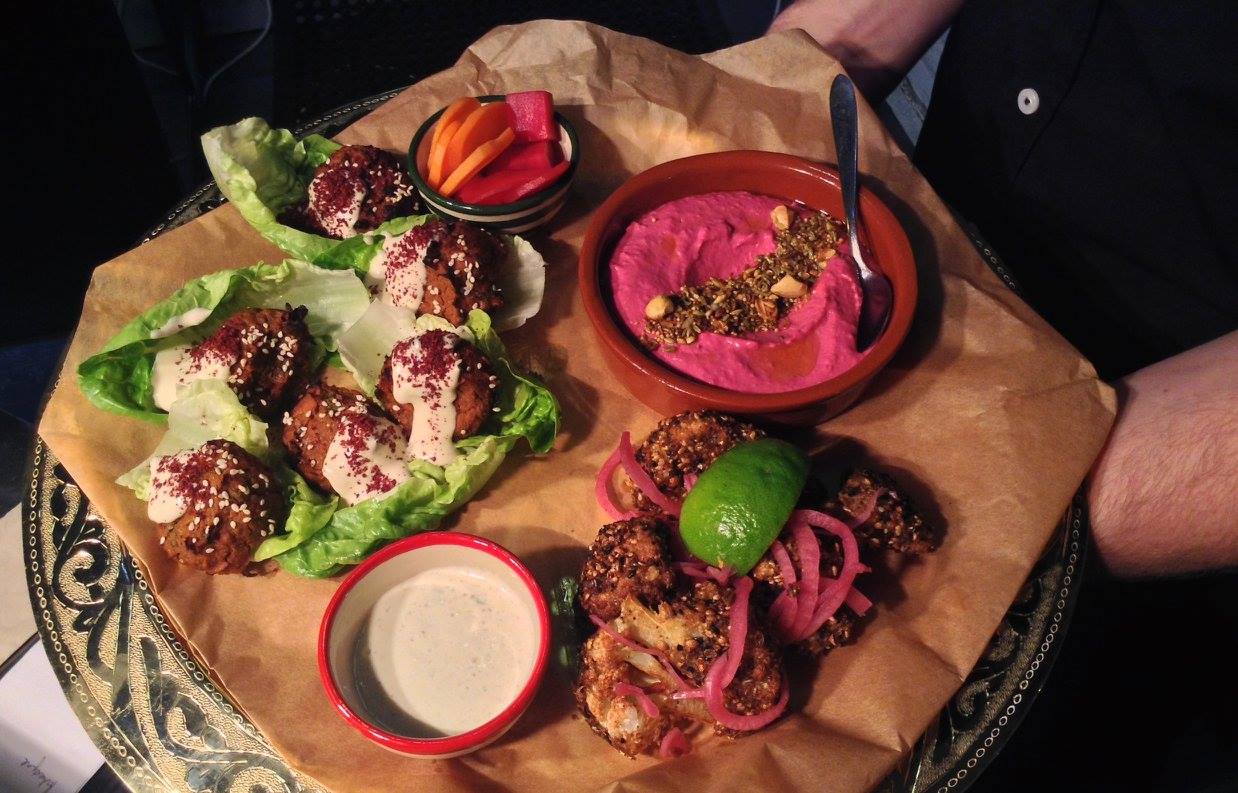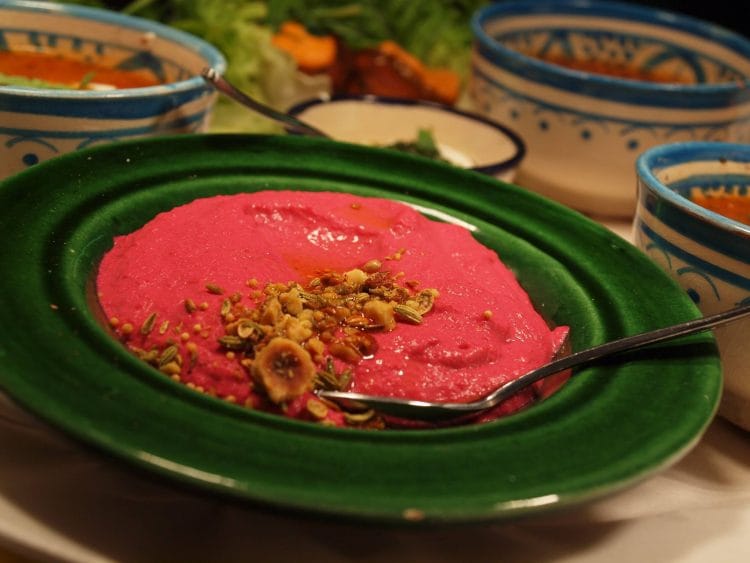What’s the best way to tell area residents about plans for a new asylum shelter nearby?
The government should tell communities directly about plans for new asylum shelters, some activists and politicians say.
Redrawing Dublin try the Middle Eastern feasting menu at Brother Hubbard on Capel Street. And ruminate on how planners should respond to the growing number of restaurants in the city.

This article is part of the Feeding Regeneration series, in which the team behind Redrawing Dublin explores how restaurants can help to regenerate areas, with articles that review restaurants while also exploring the challenges facing their neighbourhoods. There’s more on the idea behind the project here.
Our local regeneration challenge for Brother Hubbard is restaurants themselves.
How many restaurants should a city have? Can a city have too many restaurants?
These may seem like somewhat peculiar and arguably puritanical questions. They are, however, questions that city-council planners face and decide upon almost every week.
The city council has increasingly attracted controversy and criticism for refusing planning permission for restaurants and coffee shops in the city centre.
In an article in March 2014, former Irish Times Environment Editor Frank McDonald was pretty damning of the practice and the rationale behind it.
An Irish Independent article in February independent.ie/business/commercial-property/restaurants-are-latest-to-see-shortage-of-supply-34482348.html”>argued that we now have a shortage of spaces for restaurants in Dublin.

This is a particularly hot topic for Capel Street. Historically a furniture and hardware street, it has emerged in recent years a foodie destination, with a huge number and increasingly diverse line-up of restaurants.
Are there too many? When is too many? Who decides?
Well, the city council actually decides. And it has decided in the not-too-distant past that planning permission should be refused for a restaurant on Capel Street on those very grounds – there are too many.
The argument runs something like this. We need a mix of uses on city centre streets: shops to support restaurants, restaurants to support shops. It’s all about the balance. We all believe in balance.
Sounds reasonable. But what if a street organically begins to emerge as a foodie destination, yet the policy says no?
Should we not celebrate and embrace the emergence of foodie streets? Should we really be refusing restaurants in long-vacant ground-floor buildings?
What are we afraid of? Too many people eating out at night? When and how quickly do policies adapt to the market? Are our policies so inflexible?
Cities are rapidly changing. Dublin is no different. Recreation, leisure, and culture are all increasingly replacing shopping as the engines of city-centre economies. Perhaps they are changing faster, including our retail and leisure habits, than planners can imagine or keep up with.
Dining out in all manner of restaurants and coffee shops is now one of the primary driving forces in urban regeneration. As pubs struggle or reinvent themselves, restaurants continue to march forward. And so it is in Dublin.
Eating out is recognised as a huge driver of urban renaissance. Dublin has witnessed an explosion in the number, diversity, and quality of restaurants in the past decade or so. The economic crash did little to dampen the appetite of a vibrant eating-out culture in our city.
Certainly as the economy recovers we are likely to see that trend accelerate. Yes, ventilation, signage, and other basics are critically important in restaurant permissions, but can we relax a little about where they go in the very centre of our city?

It is nothing short of planning heresy, punishable by planner social ostracism, to suggest that the city should be indifferent (in a good way), supportive even, of an empty commercial unit on Henry Street or Grafton Street that wishes to reopen as a restaurant as opposed to, say, a shoe shop.
We are determined to keep restaurants out of Henry Street and are uncomfortable about their proliferation — a horrible but sadly overused word in this context — on Capel Street.
This all boils down to our addiction to over-zealous land-use zoning. Zoning is the building block of the planner’s universe. It’s that dark mysterious planning matter that is hard to see, impossible to touch, and sometimes unfathomable. It is nevertheless very real and a hugely powerful force in determining where we eat and where we sleep in our city.
Did you know Dublin has conceived of 84 different types of land use in the city?
What explains the mysteries of zoning that permit us to stay in a “hotel” or a “bed and breakfast” but not a “guesthouse” in the average suburb, that allows us to stay in a “bed and breakfast” but not a “hotel” or “guesthouse” in a “red-brick-conservation“ suburb, and allows us to stay in any of the three in a city-centre red-brick Georgian square.
Beats us!
In the last decade or so, Capel Street has emerged as one of the premier culinary areas of Dublin city. You can walk down it and pick whatever you fancy: Korean, Chinese, Irish, French, Italian – the list goes on.
We recently stumbled across the popular Brother Hubbard restaurant there, sibling of Sister Sadie on Harrington Street.
Brother Hubbard is simple and chic, with grey wooden frames, delicate Moroccan-style candle holders, and atmospheric lighting. It’s warm and inviting.
In the evening, it offers a set Middle-Eastern “feasting menu”, which you can’t opt out of: three courses for €29.95 per person, or two courses for €24.95 per person. The meal begins with an assortment of five starters for sharing.
On the night we were there, the starters included: sweet potato, coriander and chickpea falafel in pepper-tahini-lemon sauce; spiced cauliflower florets with lime-and-fennel yogurt and pickled red onion; Moroccan harira soup with baba-ganoush dressing and fresh herbs; beetroot hummous dukkah; and sa’atar flatbread with pickles.
That’s a long list. Great for sharing, but we wondered how it works if you dine alone.

For mains, we ordered the spiced hake tagine with red pepper and tomato, Jerusalem artichoke, okra and samphire, as well as the Imam Bayildi aubergine with spinach, dukkah and caramelised garlic on a bed of spiced tomato and chickpeas, garnished with lemon zest and fresh herbs.
This came with a couple of other dishes for us to share: some “wedding” couscous with lentils, caramelised onions, fruit, herbs and flowers, as well as charred stem-broccoli with fennel, red peppers and spiced butter. We asked the friendly waiter what made it “wedding” couscous. He said it was because of the flowers.
Each dish gets a detailed description, welcome and mouth-watering. Maybe it’s just me, but I wondered throughout the dinner whether or not all the described ingredients were actually on the plate.
Before I get into the food, I must reveal my origins. I am a son of Moroccan parents, both of whom emigrated from Casablanca to Tel Aviv during the 1960s. Growing up in the Israel, whether it was my grandmother’s homemade harira soup or my dad’s homemade hummus and baba-ganoush, this type of menu was my everyday food.
The starters came out on a little wooden board. The falafel balls were nestled in Little Gem lettuce leaves. Sweet-potato-and-chickpea falafel is an unusual twist on the familiar recipe. Traditionally, falafel contains chickpeas and lots of herbs and spices. For falafel purists or junkies, it may be a step to call this new version “falafel”. But it worked well.
Harira in Moroccan Arabic means “silk”. The silky texture comes from the combination of the flour and the freshly squeezed lemon – silky soft and sharp. This soup was mainly tomato with lentil and chickpeas, with a particular variation of sour yogurt on top.
Moving on to the hummus – the literal translation of “hummus” is “chickpeas” — here we got something extra. Chickpeas with beetroot is an unusual combination, but it was tasty; the hummus was creamy and the beetroot gave it a sweet flavour. Still, I wouldn’t risk it with true hummus addicts.
The cauliflower was perfect and very much in line with the traditional Middle Eastern cooking. Adding lime was beautiful.
The main courses came in small ceramic bowls.
There seemed to be some confusion, as the hake came with flakes of dried garlic, watercress leaves, dried courgette, and lots of tomato — not quite what we had expected from the menu. Still, the dish tasted wonderful. The fish absorbed the flavours from the vegetables.

Imam Bayildi is a Turkish dish usually served on a bed of a whole aubergines. Here, the aubergine were sliced and rolled, properly treated to remove any rubbery texture, and then fried.
It was gorgeous, almost a sexy dish. It had a soft and crunchy texture, was mixed with spinach leaves, and was sprinkled with the aphrodisiacal Egyptian mix of herbs and spices called dukkah.
The couscous came without flowers. We assumed there was no wedding that evening. It was cooked with lentils and raisins, and served with lime, another favourite here.
The charred stem broccoli, fennel and red peppers were cooked to perfection, with the smoky smells of the grill and a crunchy texture.
At first glance, the portions seemed small, but the combination of the versatility of tasting experience and the sheer number of dishes hugely satisfies. This place is generous.
One of us ordered the dessert platter, a combo of walnut and orange blosson baklava, homemade chocolate ice cream with hazelnut, praline, and raspberry, fresh plum and spiced orange slices, mint and pomegranate syrup, Turkish lokum. Sublime.
The desserts tasted fresh and homemade. The Turkish lokum was the best I have tasted: aromatic, soft and melting, none of that rubbery industrial Turkish-delight texture that you often get.
Overall, Brother Hubbard is a culinary delight.
Total Marks: 78/100
How do we score? We’ve come up with our own super-geeky marking system: 40 percent for food, 30 percent for the experience, 20 percent for the “regeneration impact”, a subjective take on the impact of the restaurant on the immediate area, and 10 percent for value for money.